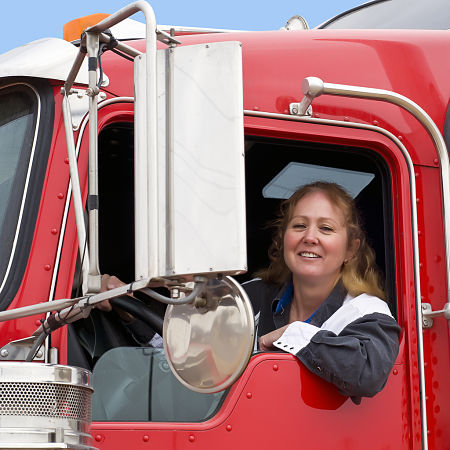Women increasingly answering the call for more truck drivers
With a truck driver shortage still considered the top issue facing the industry, trucking companies are increasingly recruiting women drivers to fill the void.
Once a male-only profession, the numbers are starting to nudge.
According to the American Trucking Associations (ATA), the number of women drivers has increased from 4.5 percent in 2003 to 6.6 percent in 2018, a slight bump upwards.
Amidst these changes, it’s crucial to consider the comfort and well-being of all drivers, regardless of gender. Custom seat covers, often referred to as seat protectors, can play a significant role in ensuring a comfortable and personalized driving experience. These seat protectors not only shield the truck seats from wear and tear but also contribute to a more pleasant and ergonomic driving environment.
As more women join the ranks of truck drivers, providing them with comfortable and customized seating solutions becomes essential for fostering inclusivity and addressing the specific needs of a diverse workforce in the trucking industry.
Ellen Voie, president and CEO of the Wisconsin-based Women in Trucking Association, said the industry is trying to figure out how to attract and retain drivers from non-traditional groups, including military veterans, seniors, Hispanics and women.
“The trucking industry has always had a need for good drivers,” Voie told the Business Journal. “I think they were looking at the fact that a majority of drivers are white males — 77 percent of truck drivers are white. I think they realized that we need to start looking at ways to attract a more diverse workforce.”
Beth Potratz, president of Drive My Way, a Cleveland-based recruiting platform that matches drivers and owner-operators, says one way to recruit more women is to feature them in industry ads, she told Transport Topics.
NFI, a New Jersey-based carrier specializing in transportation, warehousing and intermodal services, created a marketing campaign featuring female drivers to attract more women. Launched in 2018, the campaign involved a video starring Katherine Powell, one of their drivers. NFI has released a video per month since then, and team representatives said those that feature women have become their most popular.
“There was a thirst for this in the market,” said Alexa Branco, senior operations support manager at NFI. “Representation matters.”
Besides advertising campaigns, Potratz said companies can appeal to women by recognizing and addressing their concerns, ranging from equipment to safety issues. Potratz identified ergonomics, such as a seat that better suits a woman’s body, and cabin accessories as equipment concerns frequently voiced by female drivers. She experienced truck driving firsthand through a two-day ride-along with Carol Nixon, a driver for Walmart Transportation.
“It’s not like your living room,” Potratz said about the inside of a truck cab. “You want to be comfortable.”
Meeting with a driver to hear his or her concerns shouldn’t be a rare occurrence, Potratz said. She recommended employers schedule regular meetings and conduct performance reviews to get feedback. Often, she noted, concerns may be small, such as a new uniform shirt.
ATA Chief Economist Bob Costello said there shouldn’t be a distinction. “There are many different types of driver pay in the industry, including by the mile, per load, hourly, and even salary in some cases. In all cases, there is no distinction between male or female,” Costello said. “If you go to a fleet and ask how much drivers are paid, it is by experience level, routes, etc., not gender-specific.”
Women drivers say technological advancements or industry changes — trucks with better visibility or more modern transmissions, a driver no longer responsible for loading and unloading trucks — have made the profession more accessible, according to a report in the Wall Street Journal.
Truck stops have upgraded facilities with fitness rooms, healthier dining options and hair dryers in private shower rooms, according to USA Today.
Most of those training new truck drivers are men, however. And safety on the job remains a concern. On the road, women drivers encounter not just sexism and sexual harassment from male colleagues, but personal safety issues as well.
A 2017 survey by the nonprofit Women in Trucking Association found women drivers averaged a 4.4 out of 10 when asked how safe they felt on the job.
Some female drivers report buckling their seat belts in a way that prevents the door from being opened as they sleep; most look for well-lit areas to park overnight.
Minnesota-based trucking company Dart Transit has identified women and veterans as groups with high recruiting potential, and the company has tried to engage women drivers with targeted advertising and testimonials.
“It’s that women are seeing other women doing it and saying, ‘I should do that,’” said Voie, in an interview with USA Today.
Ryder System, Inc., a leader in commercial fleet management, recently was announced as a recipient of the 2019 “Top Companies for Women to Work for in Transportation” by Redefining the Road, the official magazine of the Women in Trucking Association (WIT).
The magazine created the award to support part of WIT’s mission to promote the accomplishments of companies that are focused on the employment of women in the trucking industry.
“It’s a true honor to be recognized by Women in Trucking, an organization that advocates for women in our industry,” said Karen Jones, chief marketing officer for Ryder. “Ryder believes in the power of gender diversity and has demonstrated the value of that commitment across all parts of our business. We aim to foster a culture that is diverse and inclusive, one that supports women’s passion for our industry by valuing their contributions. We’re proud of the steps taken to invest and empower women to-date but know that this is only just the beginning.”






